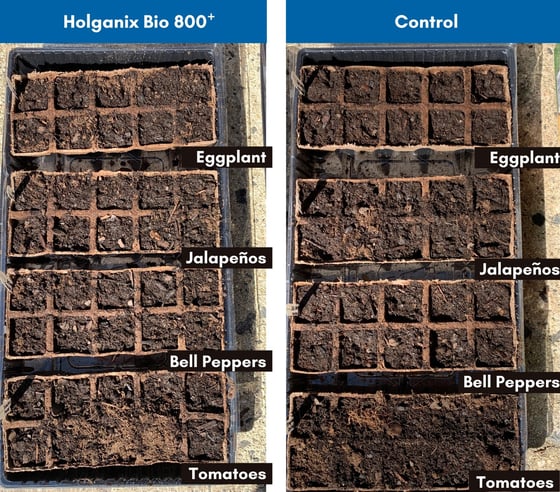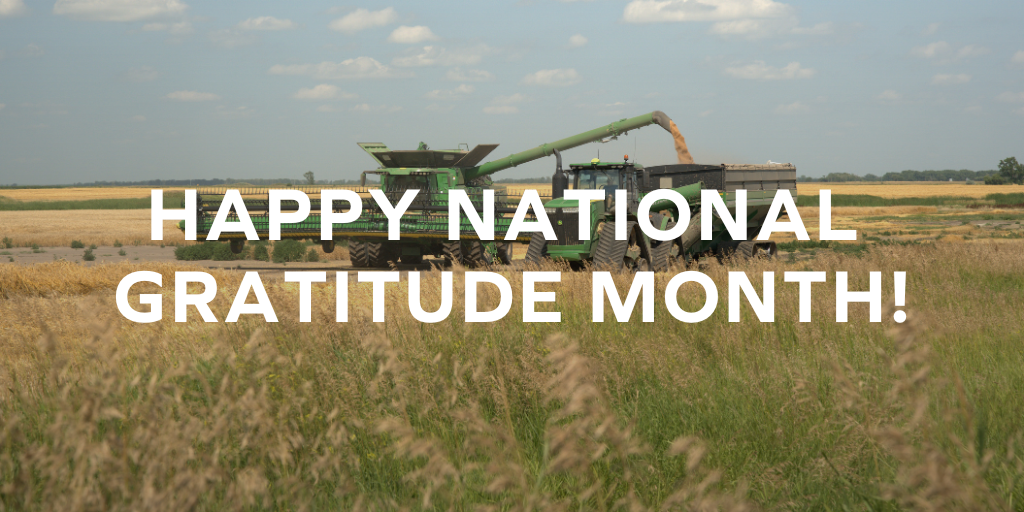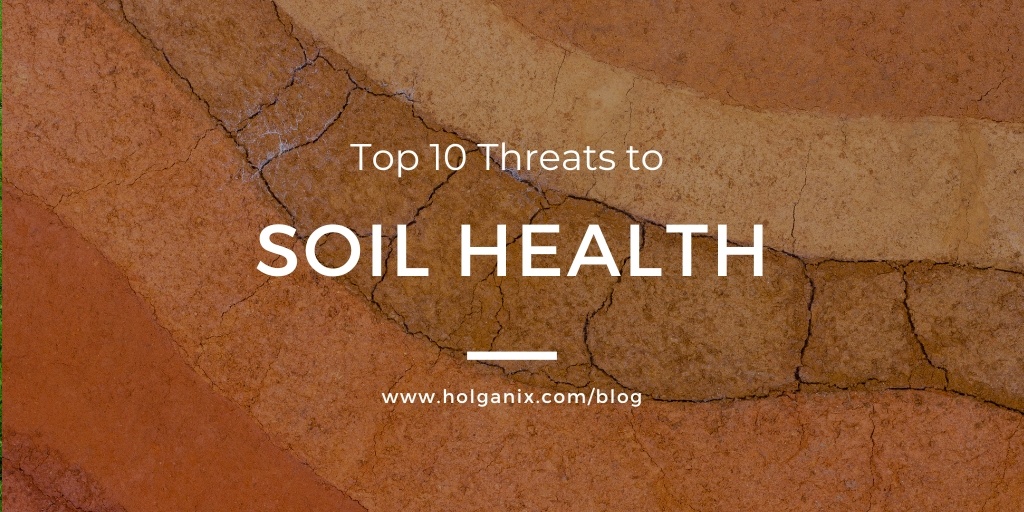.jpg?width=3072&name=Blog%20headers%20%232%20(14).jpg)
This year, the Holganix science team is conducting trials on tomatoes, eggplant, bell peppers, jalapeños, and peas, at our headquarters with the goal of measuring improvements in their seed germination.
According to our data, “seeds treated with Holganix Bio 800+ Agriculture germinated at a faster rate and had a higher germination success rate than the control,” explains Robert Neidermyer, Ph.D. and Director of Soil Science at Holganix. Further, “the data shows Holganix-treated seeds had an average of 88% germination success against the control.”
In this case study, we dig into the data around the science team’s trials. Click the link below to skip to the result that interests you most, or keep reading for the full story.
- Parameters of the Experiment
- Results from the Experiment
- How does Holganix improve seed germination?
- Additional Holganix data and customer testimonials
Parameters of the experiment
The science team planted the following vegetables:
- Ferry-Morse: Big Red, Heirloom Tomato
- Ferry-Morse: Black Beauty, Eggplant
- Ferry-Morse: Grand Bell, Mixed Color Peppers
- Ferry-Morse: Pepper, Mild Jalapeños
- Ferry Morse: Alaska, Wilt Resistant Peas
On March 16, 2022, our science team started seedling tomatoes, eggplant, bell peppers, jalapeños, and peas for the treated and controlled experiments.
Both the treated and the control (tomato, eggplant, bell pepper, and jalapeño) experiments were seeded into 1.75 inches of biodegradable peat strips, using a potting mix without any soil additives. A total of 10 seeds of each vegetable were planted into 10 individual squared peat pots. As for the peas, both the treated and untreated peas were seeded into 3 inches of biodegradable round peat pots. A total of one seed per peat pot was planted.
Each treated plant (tomato, eggplant, bell pepper, jalapeño, and peas) was sprayed with 2 ml of Holganix Bio 800+ Agriculture, at a rate of 2 oz per 1 gallon of water. Note: Holganix Bio 800+ Agriculture was applied only once throughout the indoor seedling. The controlled experiment plants were treated using water only.
Capture 1: Plants - Treated with Holganix Bio 800+ Agriculture Vs. Control

Credits: The above photos of seedling trays treated with Holganix Bio 800+ Agriculture vs. the Control were taken by the Holganix science team on March 16, 2022.
Capture 2: Peas - Treated with Holganix Bio 800+ Agriculture Vs. Control

Credits: The above photos of seedling trays treated with Holganix Bio 800+ Agriculture vs. the Control were taken by the Holganix science team on March 16, 2022.
Once seeded, both the treated and controlled planting trays were covered with a plastic cover, while the treated and untreated peas were covered using a clear saran wrap. Finally, all the seedlings were placed next to a large window for germination.
Note: All the conditions were repeated for both treated and control experiments.
Capture 3: Indoor Seedling - Treated with Holganix Bio 800+ Agriculture Vs. Control
.jpg?width=560&name=Garden%20Experiment%20-%20Blog%20Graphics%20%20(9).jpg)
Credits: The above photos of seedling trays treated with Holganix Bio 800+ Agriculture vs. the Control were taken by the Holganix science team on March 16, 2022.
Results From the experiment
On March 31, 2022, the science team counted the number of seeds germinated in each of the peat pots that were treated versus the control group. The data obtained concludes that, overall, seeds treated with Holganix Bio 800+ Agriculture had a faster germination rate than seeds that were treated with water alone.
Chart 1: Seed Germination Data

A total of 10 seeds were planted per vegetable per group (control vs treated), and our germination rate was determined by this formula: # of seeds germinated each treatment per plant)/ 10 seeds planted in total = % germination rate
- 70% seed germination rate Tomatoes – Control
- 80% seed germination rate Tomatoes – Treated with Holganix Bio 800+ Agriculture
- 90% seed germination rate Eggplant – Control
- 100% seed germination rate Eggplant – Treated with Holganix Bio 800+ Agriculture
- 50% seed germination rate Bell Peppers – Control
- 60% seed germination rate Bell Peppers – Treated with Holganix Bio 800+ Agriculture
- 90% seed germination rate Jalapeños – Control
- 100% seed germination rate Jalapeños – Treated with Holganix Bio 800+ Agriculture
- 90% seed germination rate Peas – Control
- 100% seed germination rate Peas – Treated with Holganix Bio 800+ Agriculture
Capture 4: Indoor Seedling - Seed Germination
.jpg?width=560&name=Garden%20Experiment%20-%20Blog%20Graphics%20%20(8).jpg)
Credits: The above photos of biodegradable seedling trays treated with the Holganix Bio 800+ Agriculture vs. the Control were taken by the Holganix science team on March 31, 2022.
Capture 5: Peas Seed Germination - Treated with Holganix Bio 800+ Agriculture Vs. Control
.jpg?width=520&name=Garden%20Experiment%20-%20Blog%20Graphics%20%20(5).jpg)
Credits: The above photos of biodegradable peat pots treated with Holganix Bio 800+ Agriculture vs. the Control were taken by the Holganix science team on March 31, 2022.
How does Holganix Improve Seed Germination?
There are many things that Holganix Bio 800+ Agriculture does for plants, especially when it comes to seed germination. Specifically, “bacteria in Bio 800+ Agriculture function as plant growth-promoting rhizobacteria,” explains Robert Neidermyer, Ph.D. “One role of plant-growth-promoting rhizobacteria is to promote faster and stronger (earlier and better functioning) seed germination.”
How is this done? Plant growth-promoting rhizobacteria PGPR:
- Attracts and maintains water in proximity to the seed - Certain PGPR produce plant hydrogels. These hydrogels function as moisture attractants, bringing water and storing water in proximity to plant seeds.
- Promotes seed germination by stimulating the seed and seedling - Other PGPR produces plant growth hormones that penetrate the seed coat and break the dormancy of the resting plant embryo within the seed. These hormones promote root and shoot emergence from the seed by conditioning the seed coat to enable the emergence and initiating cell division by promoting root and shoot growth.
- Stimulates seedling growth and differentiation (development of roots and shoots) - PGPR hormones also promote cell differentiation, on a type level: shoot vs root and functional level: stems, leaves, flowers, external protection, interior cells, water movement, photosynthesis, sugar movement in the plant, etc.
- Make nutrients available to plant role – PGPR in the soil promotes nitrification providing nitrogen in forms available for root uptake. Other soil PGPR release enzymes that solubilize phosphorus, potassium, and other plant minerals so that these minerals are available for root uptake.
Additional Holganix Data and Customer Testimonials
Holganix Bio 800+ Agriculture harnesses the power of over 800 species of soil microbes to improve fertilizer efficiency, increase yield, improve crop resilience against stress and boost soil health.
Be sure to check out our last year’s 2021 Garden Experiment Blog.

Looking to learn more? Over the years we have compiled data on several different crops, in different geographic zones, to deepen our understanding of how Holganix Bio 800+ Agriculture can help farmers maximize crops. Click the button below to access a sample from our 2017 - 2022 collection.


 |
July 28, 2022
|
1:45 PM
|
July 28, 2022
|
1:45 PM



.jpg?width=3072&name=Blog%20headers%20%232%20(14).jpg)


.jpg?width=560&name=Garden%20Experiment%20-%20Blog%20Graphics%20%20(9).jpg)

.jpg?width=560&name=Garden%20Experiment%20-%20Blog%20Graphics%20%20(8).jpg)
.jpg?width=520&name=Garden%20Experiment%20-%20Blog%20Graphics%20%20(5).jpg)



-1.jpg)
-1.jpg)
-1.jpg)
.jpg)

.jpg)
.webp)
-1%20(1).webp)
-831535-2.webp)




.jpg)
-1.png)